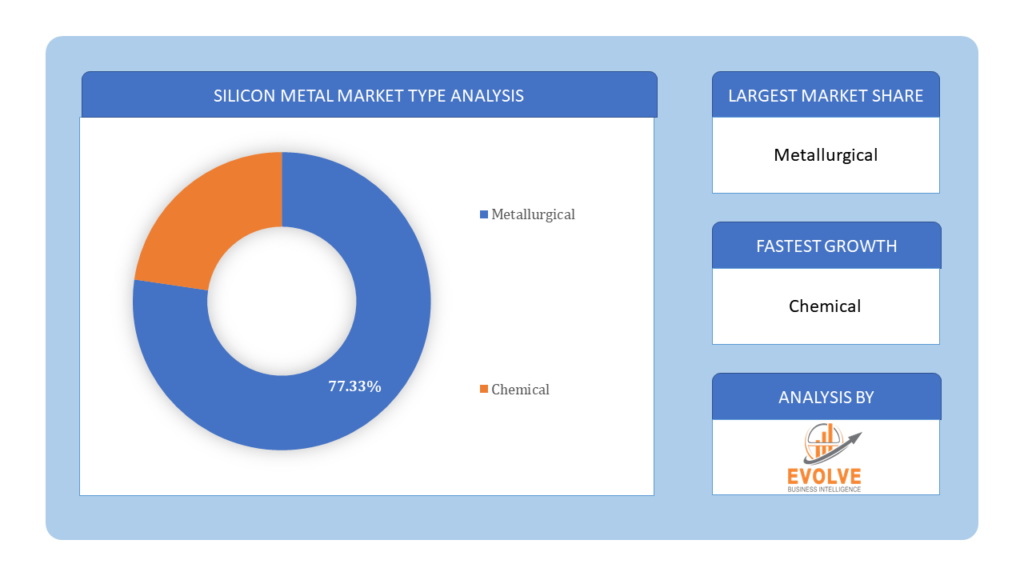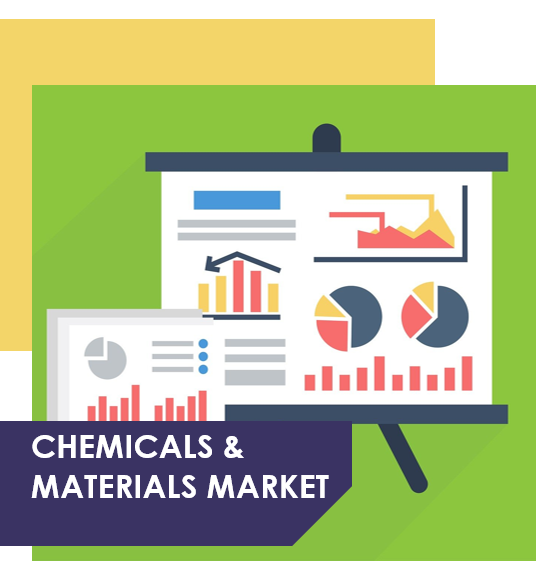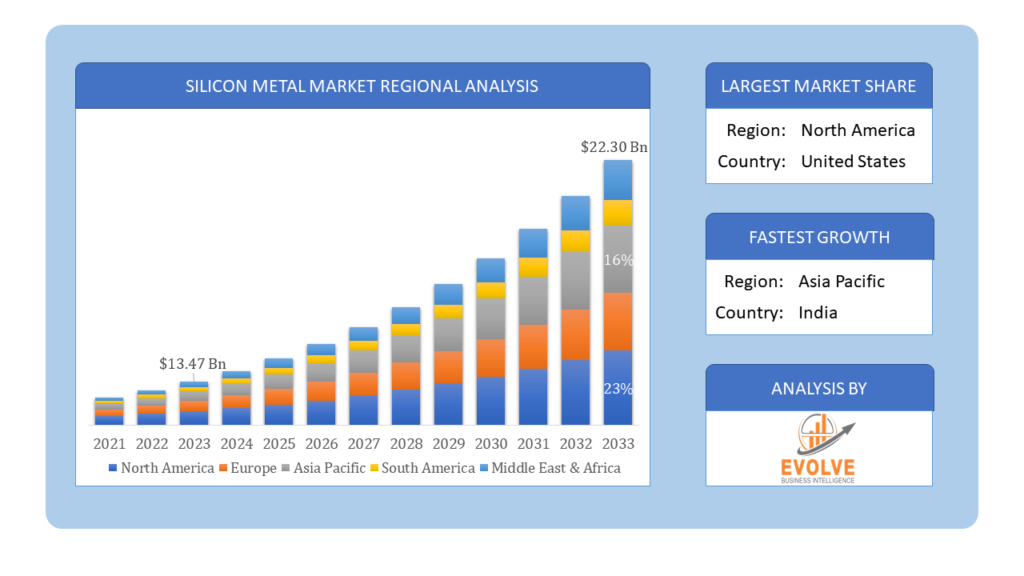Silicon Metal Market Analysis and Global Forecast 2023-2033
$ 1,390.00 – $ 5,520.00Price range: $ 1,390.00 through $ 5,520.00
Silicon Metal Market Research Report: Information By Application (Aluminum Alloys, Silicone, Semiconductors, Others), By Product Form (Metallurgical, Chemical), and by Region — Forecast till 2033
Page: 167
Silicon Metal Market Overview
The Silicon Metal Market Size is expected to reach USD 22.30 Billion by 2033. The Silicon Metal industry size accounted for USD 13.47 Billion in 2023 and is expected to expand at a compound annual growth rate (CAGR) of 5.87% from 2023 to 2033. The silicon metal market involves the production, distribution, and sale of silicon metal, a key industrial material composed primarily of silicon. It is used in various applications, including aluminum alloys, silicones, and the solar and electronics industries due to its properties like high purity and thermal conductivity. The market is driven by demand from sectors such as automotive, construction, and technology. Growth is influenced by factors such as technological advancements, renewable energy trends, and economic conditions. Major producers include China, Brazil, and the United States. Environmental regulations and supply chain dynamics also significantly impact the market.
Global Silicon Metal Market Synopsis
The COVID-19 pandemic has led to supply chain disruptions leading to supply shortages or lower demand in the Silicon Metal market. The travel restrictions and social-distancing measures have resulted in a sharp drop in consumer and business spending and this pattern is to continue for some time. The end-user trend and preferences have changed due to the pandemic and have resulted in manufacturers, developers, and service providers to adopt various strategies to stabilize the company.
Silicon Metal Market Dynamics
The major factors that have impacted the growth of Silicon Metal are as follows:
Drivers:
Ø Technological Advancements
The rapid advancement in technology, particularly in electronics and photovoltaics (solar panels), has significantly increased the demand for high-purity silicon metal. Silicon metal is a critical component in the manufacturing of semiconductors, which are essential for various electronic devices including computers, smartphones, and other consumer electronics.
Restraint:
- Technological Limitations
While there is ongoing innovation in the silicon metal industry, certain technological limitations still exist. For example, achieving ultra-high purity silicon required for advanced semiconductor and photovoltaic applications is complex and costly. Additionally, alternatives and substitutes for silicon in certain applications, such as the development of new materials for electronics, can pose a threat to the market.
Opportunity:
⮚ Advancements in Manufacturing Technologies
The adoption of advanced manufacturing technologies, such as automation, artificial intelligence, and the Internet of Things (IoT), can enhance production efficiency and reduce costs in the silicon metal industry. These technologies enable precise control over production processes, improve yield rates, and reduce energy consumption, making silicon metal production more sustainable and cost-effective. Embracing Industry 4.0 practices can provide a competitive edge to market players.
Silicon Metal Segment Overview
By Application
Based on Application, the market is segmented based on Aluminum Alloys, Silicone, Semiconductors, Others. Based on application, the silicon metal market is dominated by the aluminum alloys segment, driven by its critical role in the automotive and construction industries for producing lightweight and durable materials.
By Product Form
 Based on Product Form, the market has been divided into the Metallurgical, Chemical. The silicon metal market is segmented into metallurgical-grade and chemical-grade products. Metallurgical-grade silicon dominates the market due to its extensive use in aluminum alloys, steel manufacturing, and the automotive industry.
Based on Product Form, the market has been divided into the Metallurgical, Chemical. The silicon metal market is segmented into metallurgical-grade and chemical-grade products. Metallurgical-grade silicon dominates the market due to its extensive use in aluminum alloys, steel manufacturing, and the automotive industry.
Global Silicon Metal Market Regional Analysis
Based on region, the global Silicon Metal market has been divided into North America, Europe, Asia-Pacific, the Middle East & Africa, and Latin America. North America is projected to dominate the use of the Silicon Metal market followed by the Asia-Pacific and Europe regions.
 Silicon Metal North America Market
Silicon Metal North America Market
North America holds a dominant position in the Silicon Metal Market. In North America, the silicon metal market is driven by strong demand from the automotive and construction industries, particularly for aluminum alloys and silicones. The region benefits from advanced technological capabilities and significant investments in renewable energy projects, such as solar power. The United States is a major player, with a focus on high-purity silicon for semiconductor applications. However, market growth is influenced by trade policies, environmental regulations, and fluctuations in raw material prices.
Silicon Metal Asia-Pacific Market
The Asia-Pacific region has indeed emerged as the fastest-growing market for the Silicon Metal industry. The Asia-Pacific silicon metal market is the largest and fastest-growing region, driven by robust industrialization and significant demand from the electronics, automotive, and construction sectors. China dominates production and consumption, supported by its extensive manufacturing infrastructure and government policies promoting renewable energy and advanced technologies. Other key markets include Japan, South Korea, and India, where increasing investments in solar energy and semiconductor industries further propel market growth.
Competitive Landscape
The global Silicon Metal market is highly competitive, with numerous players offering a wide range of software solutions. The competitive landscape is characterized by the presence of established companies, as well as emerging startups and niche players. To increase their market position and attract a wide consumer base, the businesses are employing various strategies, such as product launches, and strategic alliances.
Prominent Players:
- Anyang Wanhua Metal Material Co. Ltd
- Dow Inc
- Elkem ASA
- Ferroglobe PLC
- Henan ALOY New Material Co. Ltd
- Hoshine Silicon Industry Co. Ltd.
- Liasa
- Mississippi Silicon LLC
- Shin-Etsu Chemical Co. Ltd.
- UNITED COMPANY RUSAL.
Key Development
In September 2022, Mississippi Silicon LLC announced a significant expansion of its silicon metal production capacity, enhancing its output to meet growing market demand in various industrial applications.
Scope of the Report
Global Silicon Metal Market, by Application
- Aluminum Alloys
- Silicone
- Semiconductors
- Others
Global Silicon Metal Market, by Type
- Metallurgical
- Chemical
Global Silicon Metal Market, by Region
- North America
- US
- Canada
- Mexico
- Europe
- UK
- Germany
- France
- Italy
- Spain
- Benelux
- Nordic
- Rest of Europe
- Asia Pacific
- China
- Japan
- South Korea
- Indonesia
- Austalia
- Malaysia
- India
- Rest of Asia Pacific
- South America
- Brazil
- Argentina
- Rest of South America
- Middle East & Africa
- Saudi Arabia
- UAE
- Egypt
- South Africa
- Rest of Middle East & Africa
| Parameters | Indicators |
|---|---|
| Market Size | 2033: $22.30 Billion |
| CAGR | 5.87% CAGR (2023-2033) |
| Base year | 2022 |
| Forecast Period | 2023-2033 |
| Historical Data | 2021 |
| Report Coverage | Revenue Forecast, Competitive Landscape, Growth Factors, and Trends |
| Key Segmentations | Application, Product Form |
| Geographies Covered | North America, Europe, Asia-Pacific, Latin America, Middle East, Africa |
| Key Vendors | Anyang Wanhua Metal Material Co. Ltd, Dow Inc, Elkem ASA, Ferroglobe PLC, Henan ALOY New Material Co. Ltd, Hoshine Silicon Industry Co. Ltd., Liasa, Mississippi Silicon LLC, Shin-Etsu Chemical Co. Ltd., UNITED COMPANY RUSAL |
| Key Market Opportunities | • The rise of e-commerce |
| Key Market Drivers | • Technological Advancements • Increasing Urbanization |
REPORT CONTENT BRIEF:
- High-level analysis of the current and future Silicon Metal market trends and opportunities
- Detailed analysis of current market drivers, restraining factors, and opportunities in the future
- Silicon Metal market historical market size for the year 2021, and forecast from 2023 to 2033
- Silicon Metal market share analysis at each product level
- Competitor analysis with detailed insight into its product segment, Government & Defense strength, and strategies adopted.
- Identifies key strategies adopted including product launches and developments, mergers and acquisitions, joint ventures, collaborations, and partnerships as well as funding taken and investment done, among others.
- To identify and understand the various factors involved in the global Silicon Metal market affected by the pandemic
- To provide a detailed insight into the major companies operating in the market. The profiling will include the Government & Defense health of the company’s past 2-3 years with segmental and regional revenue breakup, product offering, recent developments, SWOT analysis, and key strategies.
Press Release

Global Pharmaceutical Manufacturing Market to Reach $1.38 Trillion by 2035 with 7.35% CAGR, New Research Shows

The Global Mammography Market Is Estimated To Record a CAGR of Around 10.29% During The Forecast Period

Glue Stick Market to Reach USD 2.35 Billion by 2034

Podiatry Service Market to Reach USD 11.88 Billion by 2034

Microfluidics Technology Market to Reach USD 32.58 Billion by 2034

Ferric Chloride Market to Reach USD 10.65 Billion by 2034

Family Practice EMR Software Market to Reach USD 21.52 Billion by 2034

Electric Hairbrush Market to Reach USD 15.95 Billion by 2034

Daily Bamboo Products Market to Reach USD 143.52 Billion by 2034

Cross-border E-commerce Logistics Market to Reach USD 112.65 Billion by 2034
Frequently Asked Questions (FAQ)
1.What is the study period of this market?
- The study period of the global Silicon Metal market is 2021- 2033
2.What is the growth rate of the global Silicon Metal market?
- The global Silicon Metal market is growing at a CAGR of 5.87% over the next 10 years
3.Which region has the highest growth rate in the market of Frozen Food?
- Asia Pacific is expected to register the highest CAGR during 2023-2033
4.Which region has the largest share of the global Silicon Metal market?
- North America holds the largest share in 2022
5.Who are the key players in the global Silicon Metal market?
Anyang Wanhua Metal Material Co. Ltd, Dow Inc, Elkem ASA, Ferroglobe PLC, Henan ALOY New Material Co. Ltd, Hoshine Silicon Industry Co. Ltd., Liasa, Mississippi Silicon LLC, Shin-Etsu Chemical Co. Ltd., and UNITED COMPANY RUSAL. are the major companies operating in the market
6.Do you offer Post Sale Support?
- Yes, we offer 16 hours of analyst support to solve the queries
7.Do you sell particular sections of a report?
Yes, we provide regional as well as country-level reports. Other than this we also provide a sectional report. Please get in contact with our sales representatives
Table of Content
Chapter 1. Executive Summary Chapter 2. Scope Of The Study 2.1. Market Definition 2.2. Scope Of The Study 2.2.1. Objectives of Report 2.2.2. Limitations 2.3. Market Structure Chapter 3. Evolve BI Methodology Chapter 4. Market Insights and Trends 4.1. Supply/ Value Chain Analysis 4.1.1. Raw Product Form s Providers 4.1.2. Manufacturing Process 4.1.3. Distributors/Retailers 4.1.4. End-Use Industry 4.2. Porter’s Five Forces Analysis 4.2.1. Threat Of New Entrants 4.2.2. Bargaining Power Of Buyers 4.2.3. Bargaining Power Of Suppliers 4.2.4. Threat Of Substitutes 4.2.5. Industry Rivalry 4.3. Impact Of COVID-19 on the Silicon Metal Market 4.3.1. Impact on Market Size 4.3.2. End-Use Industry Trend, Preferences, and Budget Impact 4.3.3. Regulatory Framework/Government Policies 4.3.4. Key Players' Strategy to Tackle Negative Impact 4.3.5. Opportunity Window 4.4. Technology Overview 12.28. Macro factor 4.6. Micro Factor 4.7. Demand Supply Gap Analysis of the Silicon Metal Market 4.8. Import Analysis of the Silicon Metal Market 4.9. Export Analysis of the Silicon Metal Market Chapter 5. Market Dynamics 5.1. Introduction 5.2. DROC Analysis 5.2.1. Drivers 5.2.2. Restraints 5.2.3. Opportunities 5.2.4. Challenges 5.3. Patent Analysis 5.4. Industry Roadmap 5.5. Parent/Peer Market Analysis Chapter 6. Global Silicon Metal Market, By Application 6.1. Introduction 6.2. Aluminum Alloys 6.3. Silicone 6.4. Semiconductors 6.5. Others Chapter 7. Global Silicon Metal Market, By Product Form 7.1. Introduction 7.2. Metallurgical 7.3. Chemical Chapter 8. Global Silicon Metal Market, By Region 8.1. Introduction 8.2. North America 8.2.1. Introduction 8.2.2. Driving Factors, Opportunity Analyzed, and Key Trends 8.2.3. Market Size and Forecast, By Country, 2023-2033 8.2.4. Market Size and Forecast, By Application, 2023-2033 8.2.5. Market Size and Forecast, By Product Form, 2023-2033 8.2.6. US 8.2.6.1. Introduction 8.2.6.2. Driving Factors, Opportunity Analyzed, and Key Trends 8.2.6.3. Market Size and Forecast, By Application, 2023-2033 8.2.6.4. Market Size and Forecast, By Product Form, 2023-2033 8.2.7. Canada 8.2.7.1. Introduction 8.2.7.2. Driving Factors, Opportunity Analyzed, and Key Trends 8.2.7.4. Market Size and Forecast, By Application, 2023-2033 8.2.7.5. Market Size and Forecast, By Product Form, 2023-2033 8.3. Europe 8.3.1. Introduction 8.3.2. Driving Factors, Opportunity Analyzed, and Key Trends 8.3.3. Market Size and Forecast, By Country, 2023-2033 8.3.4. Market Size and Forecast, By Application, 2023-2033 8.3.5. Market Size and Forecast, By Product Form, 2023-2033 8.3.6. Germany 8.3.6.1. Introduction 8.3.6.2. Driving Factors, Opportunity Analyzed, and Key Trends 8.3.6.3. Market Size and Forecast, By Application, 2023-2033 8.3.6.4. Market Size and Forecast, By Product Form, 2023-2033 8.3.7. France 8.3.7.1. Introduction 8.3.7.2. Driving Factors, Opportunity Analyzed, and Key Trends 8.3.7.3. Market Size and Forecast, By Application, 2023-2033 8.3.7.4. Market Size and Forecast, By Product Form, 2023-2033 8.3.8. UK 8.3.8.1. Introduction 8.3.8.2. Driving Factors, Opportunity Analyzed, and Key Trends 8.3.8.3. Market Size and Forecast, By Application, 2023-2033 8.3.8.4. Market Size and Forecast, By Product Form, 2023-2033 8.3.9. Italy 8.3.9.1. Introduction 8.3.9.2. Driving Factors, Opportunity Analyzed, and Key Trends 8.3.9.3. Market Size and Forecast, By Application, 2023-2033 8.3.9.4. Market Size and Forecast, By Product Form, 2023-2033 8.3.11. Rest Of Europe 8.3.11.1. Introduction 8.3.11.2. Driving Factors, Opportunity Analyzed, and Key Trends 8.3.11.3. Market Size and Forecast, By Application, 2023-2033 8.3.11.4. Market Size and Forecast, By Product Form, 2023-2033 8.4. Asia-Pacific 8.4.1. Introduction 8.4.2. Driving Factors, Opportunity Analyzed, and Key Trends 8.4.3. Market Size and Forecast, By Country, 2023-2033 8.4.4. Market Size and Forecast, By Application, 2023-2033 8.12.28. Market Size and Forecast, By Product Form, 2023-2033 8.4.6. China 8.4.6.1. Introduction 8.4.6.2. Driving Factors, Opportunity Analyzed, and Key Trends 8.4.6.3. Market Size and Forecast, By Application, 2023-2033 8.4.6.4. Market Size and Forecast, By Product Form, 2023-2033 8.4.7. India 8.4.7.1. Introduction 8.4.7.2. Driving Factors, Opportunity Analyzed, and Key Trends 8.4.7.3. Market Size and Forecast, By Application, 2023-2033 8.4.7.4. Market Size and Forecast, By Product Form, 2023-2033 8.4.8. Japan 8.4.8.1. Introduction 8.4.8.2. Driving Factors, Opportunity Analyzed, and Key Trends 8.4.8.3. Market Size and Forecast, By Application, 2023-2033 8.4.8.4. Market Size and Forecast, By Product Form, 2023-2033 8.4.9. South Korea 8.4.9.1. Introduction 8.4.9.2. Driving Factors, Opportunity Analyzed, and Key Trends 8.4.9.3. Market Size and Forecast, By Application, 2023-2033 8.4.9.4. Market Size and Forecast, By Product Form, 2023-2033 8.4.10. Rest Of Asia-Pacific 8.4.10.1. Introduction 8.4.10.2. Driving Factors, Opportunity Analyzed, and Key Trends 8.4.10.3. Market Size and Forecast, By Application, 2023-2033 8.4.10.4. Market Size and Forecast, By Product Form, 2023-2033 8.5. Rest Of The World (RoW) 8.5.1. Introduction 8.5.2. Driving Factors, Opportunity Analyzed, and Key Trends 8.5.3. Market Size and Forecast, By Application, 2023-2033 8.5.4. Market Size and Forecast, By Product Form, 2023-2033 Chapter 9. Company Landscape 9.1. Introduction 9.2. Vendor Share Analysis 9.3. Key Development Analysis 9.4. Competitor Dashboard Chapter 10. Company Profiles 10.1. Anyang Wanhua Metal Material Co. Ltd 10.1.1. Business Overview 10.1.2. Government & Defense Analysis 10.1.2.1. Government & Defense – Existing/Funding 10.1.3. Product Portfolio 10.1.4. Recent Development and Strategies Adopted 10.1.5. SWOT Analysis 10.2. Dow Inc 10.2.1. Business Overview 10.2.2. Government & Defense Analysis 10.2.2.1. Government & Defense – Existing/Funding 10.2.3. Product Portfolio 10.2.4. Recent Development and Strategies Adopted 10.2.5. SWOT Analysis 10.3. Elkem ASA 10.3.1. Business Overview 10.3.2. Government & Defense Analysis 10.3.2.1. Government & Defense – Existing/Funding 10.3.3. Product Portfolio 10.3.4. Recent Development and Strategies Adopted 10.3.5. SWOT Analysis 10.4. Ferroglobe PLC 10.4.1. Business Overview 10.4.2. Government & Defense Analysis 10.4.2.1. Government & Defense – Existing/Funding 10.4.3. Product Portfolio 10.4.4. Recent Development and Strategies Adopted 10.12.28. SWOT Analysis 10.5. Henan ALOY New Material Co. Ltd 10.5.1. Business Overview 10.5.2. Government & Defense Analysis 10.5.2.1. Government & Defense – Existing/Funding 10.5.3. Product Portfolio 10.5.4. Recent Development and Strategies Adopted 10.5.5. SWOT Analysis 10.6. Hoshine Silicon Industry Co. Ltd. 10.6.1. Business Overview 10.6.2. Government & Defense Analysis 10.6.2.1. Government & Defense – Existing/Funding 10.6.3. Product Portfolio 10.6.4. Recent Development and Strategies Adopted 10.6.5. SWOT Analysis 10.7. Liasa 10.7.1. Business Overview 10.7.2. Government & Defense Analysis 10.7.2.1. Government & Defense – Existing/Funding 10.7.3. Product Portfolio 10.7.4. Recent Development and Strategies Adopted 10.7.5. SWOT Analysis 10.8 Mississippi Silicon LLC 10.8.1. Business Overview 10.8.2. Government & Defense Analysis 10.8.2.1. Government & Defense – Existing/Funding 10.8.3. Product Portfolio 10.8.4. Recent Development and Strategies Adopted 10.8.5. SWOT Analysis 10.9 Shin-Etsu Chemical Co. Ltd. 10.9.1. Business Overview 10.9.2. Government & Defense Analysis 10.9.2.1. Government & Defense – Existing/Funding 10.9.3. Product Portfolio 10.9.4. Recent Development and Strategies Adopted 10.9.5. SWOT Analysis 10.10. UNITED COMPANY RUSAL. 10.10.1. Business Overview 10.10.2. Government & Defense Analysis 10.10.2.1. Government & Defense – Existing/Funding 10.10.3. Product Portfolio 10.10.4. Recent Development and Strategies Adopted 10.10.5. SWOT Analysis
Connect to Analyst
Research Methodology








